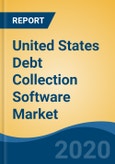Speak directly to the analyst to clarify any post sales queries you may have.
10% Free customizationThis report comes with 10% free customization, enabling you to add data that meets your specific business needs.
The United States Debt Collection Software Market is segmented based on organization size, deployment mode, component, user type, region and company. Based on organization size, the market is bifurcated into large enterprises and small and medium-sized enterprises. Out of which, utility of the debt collection software in large enterprises is much higher when compared to that of small and medium-sized enterprises (SMEs). This high demand can be attributed to the benefits offered by debt collection to large scale organizations due to its affordability and economies of scale. In addition to this, surging requirement for multichannel communication as well as improvement in the collection process through automation is likely to boost the segment growth over the coming years.
Major players operating in the United States Debt Collection Software Market include FIS, FICO, TransUnion, Pegasystems, Chetu, Katabat, CGI, Temenos and others. Majority of the companies are using email, mobile consumer portals, phone and interactive text messages to contact their customers. With the help of debt collection software, the companies are assisting their clients in solving their debt challenges.
Years considered for this report:
- Historical Years: 2015–2018
- Base Year: 2019
- Estimated Year: 2020
- Forecast Period: 2021–2025
Objective of the Study:
- To analyze and forecast the market size of the United States Debt Collection Software Market.
- To classify and forecast the United States Debt Collection Software Market based on organization size, deployment mode, component, user type, company and regional distribution.
- To identify drivers and challenges for the United States Debt Collection Software Market.
- To examine competitive developments such as expansions, new product launches, mergers & acquisitions, etc., in the United States Debt Collection Software Market.
- To conduct pricing analysis for the United States Debt Collection Software Market.
- To identify and analyze the profile of leading players operating in the United States Debt Collection Software Market.
The author performed both primary as well as exhaustive secondary research for this study. Initially, they sourced a list of service providers across the region. Subsequently, they conducted primary research surveys with the identified companies. While interviewing, the respondents were also enquired about their competitors. Through this technique, they could include the service providers which could not be identified due to the limitations of secondary research. The author analyzed the service providers, distribution channels and presence of all major players across the region.
The author calculated the market size of the United States Debt Collection Software Market by using a bottom-up approach, wherein the data for various end-user segments was recorded and forecast for the future years. They sourced these values from the industry experts and company representatives and externally validated through analyzing historical data of these product types and applications for getting an appropriate, overall market size. Various secondary sources such as company websites, news articles, press releases, company annual reports, investor presentations and financial reports were also studied.
Key Target Audience:
- Debt collection software service providers, vendors and other stakeholders
- Government bodies such as regulating authorities and policy makers
- Organizations, forums and alliances related to debt collection software
- Market research and consulting firms
The study is useful in providing answers to several critical questions that are important for the industry stakeholders such as service providers and partners, end-users, etc., besides allowing them in strategizing investments and capitalizing on the market opportunities.
Report Scope:
In this report, the United States Debt Collection Software Market has been segmented into following categories, in addition to the industry trends which have also been detailed below:
Market, By Organization Size:
- SMEs
- Large Enterprises
Market, By Deployment Mode:
- On-Premise
- Cloud
Market, By Component:
- Software
- Services
Market, By User Type:
- Financial Institutions
- Collection Agencies
- Healthcare
- Government
- Telecom and Utilities
- Others
- Regions:
- West
- Northeast
- Midwest
- South
Competitive Landscape:
- Company Profiles: Detailed analysis of the major companies present in the United States Debt Collection Software Market.
Available Customizations:
With the given market data, the author offers customizations according to a client’s specific needs.
Table of Contents
Companies Mentioned
- FIS
- FICO
- TransUnion
- Pegasystems
- Chetu
- Katabat
- CGI
- Temenos








